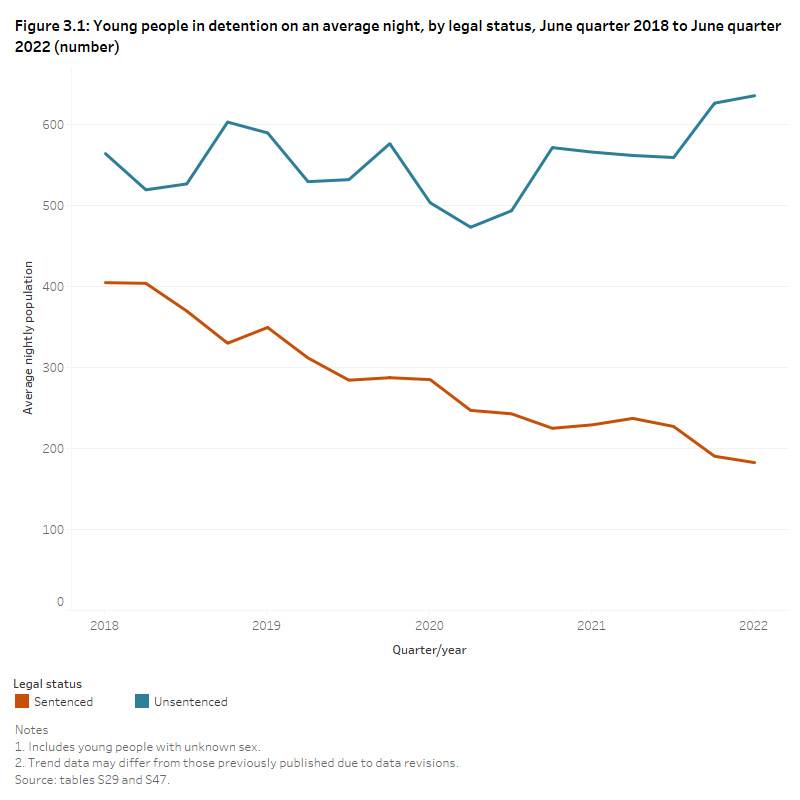Numbers
On an average night in the June quarter 2022, almost 4 in 5 (636 or 78%) young people in detention were unsentenced. The remainder (183 or 22%) were serving a sentence (Figure 3.1).
The proportion of young people in sentenced detention has fallen over time from 42% in the June quarter 2018 to 22% in the June quarter 2022. Conversely, the proportion of those in unsentenced detention has increased from 58% to 78% over the same period (tables S29 and S47).
The number of young people in unsentenced detention fluctuated over the 4‑year period, with a low of 473 in the September quarter 2020 and a high of 636 in the June quarter 2022. The number of young people in unsentenced detention tended to be higher in the March and June quarters each year, except in the June quarter 2020 (Figure 3.1).
The number of young people in unsentenced detention has increased since the June quarter 2021 (566 compared with 636 young people in the June quarter 2022) (Figure 3.1).
The number of young people in sentenced detention has steadily declined (55%) over the 4-year period. There were 405 young people in sentenced detention on an average night in the June quarter 2018 compared with 183 young people in the June quarter 2022. The June quarter 2018 had the highest number of young people in sentenced detention (Table S47).
Figure 3.1: Young people in detention on an average night, by legal status, Australia, June quarter 2018 to June quarter 2022 (number)
This line graph shows 2 lines comparing the average nightly detention population for young people with a legal status of ‘sentenced’ or ‘unsentenced’. More young people in detention were unsentenced than sentenced over the 4-year period. The number of young people in sentenced detention declined from the June quarter 2018. The number of young people in unsentenced detention has fluctuated between quarters but showed no trend over the long term.

In the June quarter 2022, a higher proportion of those in unsentenced detention were aged 10–17 (92%), compared with sentenced detention (69%). Conversely, only 8.2% of those in unsentenced detention and 31% of those in sentenced detention were aged 18 or over.
Higher proportions of young people aged 10–17 in unsentenced over sentenced detention were consistent throughout the 4-year period, with:
- 89%–93% of those in unsentenced detention being aged 10–17
- 54%–69% of those in sentenced detention being aged 10–17, with a low in the September quarter 2020 and a high in the June quarter 2022 (tables S29, S32, S47, and S50).
Additionally, in the June quarter 2022, 6.8% of young people in unsentenced detention were aged 10–13 and less than 1% (0.6%) in sentenced detention were aged 10–13. These proportions fluctuated over the 4-year period from the June quarter 2018 to the June quarter 2022 for unsentenced detention (5.5%–8.3%) and sentenced detention (0.0%–1.8%) (tables S29, S30, S47, S48).
One reason more young people aged 18 and over are in sentenced detention than in unsentenced detention is that some might continue serving a sentence in a youth facility once they turn 18. Whether they remain in youth detention or are moved to the adult justice system depends on different policies and practices in the states and territories.
For example, in Victoria, 62%–78% of young people in sentenced detention were aged 18 or over in each quarter over the 4-year period, compared with 31%–46% in Australia overall. This is in part due to the ‘dual track’ sentencing system operating in Victoria, which results in a relatively large proportion of young people aged 18 and over in sentenced detention (see Chapter 1 for more details).
On an average night in the June quarter 2022, a higher proportion of females (82%) than males (77%) in detention were unsentenced (tables S29 and S11). This was the case in each quarter throughout the 4‑year period, with:
- 73%–82% of females in detention unsentenced
- 54%–77% of males in detention unsentenced.
Conversely, a higher proportion of males (23%) than females (18%) were in sentenced detention on an average night in the June quarter 2022 (tables S47 and S11). But due to the small number of females in detention, these results should be interpreted with caution.
Over the 4-year period, the proportion of males in sentenced detention declined from 44% in the June quarter 2018 to 23% in the June quarter 2022.


